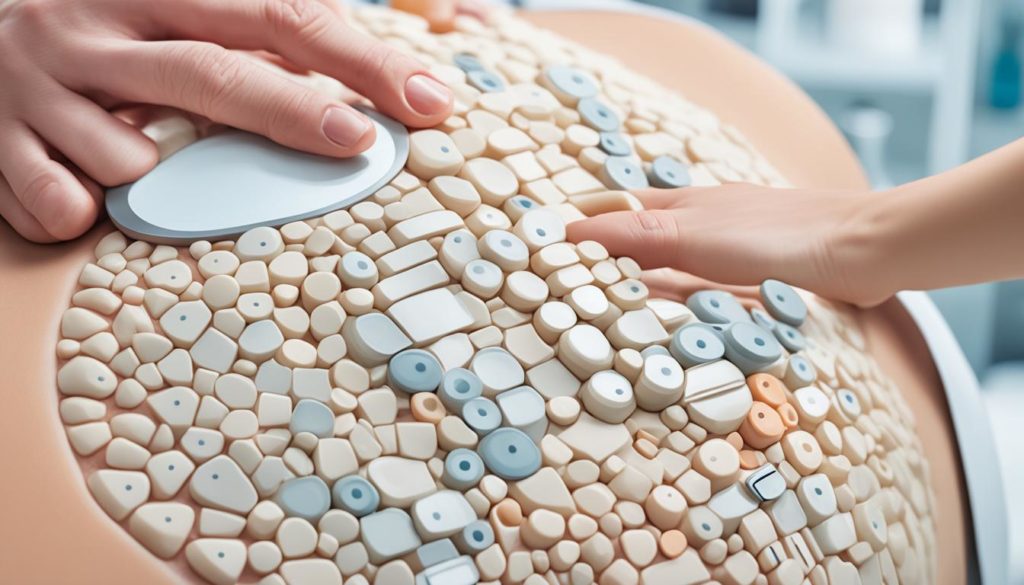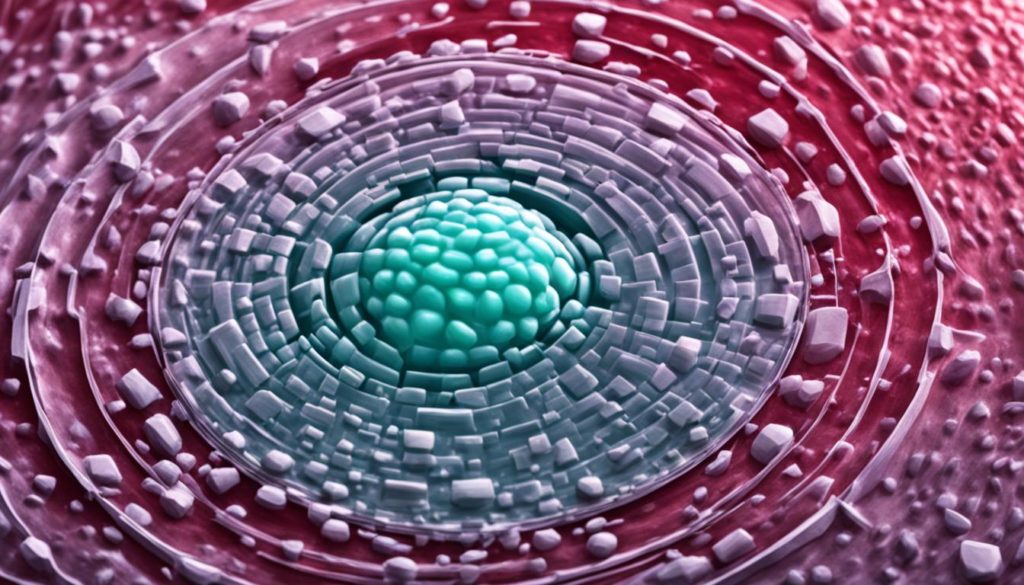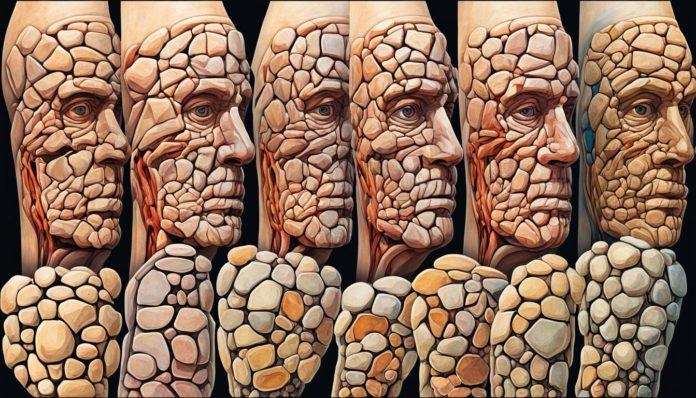About 20% of adults will get a skin cyst during their life. This condition ranges from harmless to concerning depending on the cyst.
Various factors, like genetics, infections, and trauma, can cause cysts and lumps. It’s important to know about them to keep your skin healthy and know how to treat them.
We’ll look at the different types of cysts and lumps, their causes, symptoms, and how to treat them. By the end, you’ll know how to manage these common skin issues.
Key Takeaways
- About 20% of adults will face a skin cyst sometime.
- Genetics, infections, and injury can lead to cysts and lumps.
- Knowing about skin growths helps in proper care.
- Spotting and diagnosing skin cysts early is key to finding the best treatment.
- This guide goes deep into symptoms, causes, and how to treat them.
Introduction to Skin Cysts and Lumps
Skin cysts and lumps are often the cause of worry, leading many to get checked. Knowing the types is key for effective treatment. This knowledge helps manage skin concerns better.

What are Skin Cysts?
Skin cysts are non-cancerous, tissue-filled pockets. They can hold fluid, pus, or other material. These round bumps come in many sizes. Cysts can show up anywhere on the body, caused by infections, blocked glands, or injuries. Types of skin cysts like epidermoid and sebaceous cysts have their own traits.
Common Types of Skin Lumps
Skin lumps include many different conditions, from mild to serious. Here are some common ones:
- Cysts are usually safe fluid-filled sacs but sometimes get infected.
- Lipomas, or fatty nodules, are mostly harmless.
- Dermatofibromas are firm lumps coming from fibroblast accumulation.
- Fibromas come from fibrous tissue but are benign.
Getting a proper checkup matters for right treatment. This can tell apart the many lump types, ensuring correct care.
Why Understanding Them Matters
Knowing about types of skin cysts and lumps affects treatment options. Identifying them correctly separates harmless from harmful, leading to precise care. Learning about skin changes helps get timely help and avoids stress.
Common Causes of Skin Cysts
Knowing why skin lumps and cysts appear is key to stopping and treating them. They often result from a mix of factors. This could be genetic traits, infections, or injuries.
Genetic Factors
Genes play a big role in creating benign skin lumps. A family history means you might have a higher chance of getting them. Genetic changes can alter skin cells’ growth, leading to cysts.
Infections and Inflammation
Infections and swelling also lead to cysts and lumps. Skin infections can build up pus, forming abscesses. Issues like acne can block hair follicles, causing cysts. Diseases causing long-term inflammation also raise the risk.
Skin Injuries and Trauma
Injuries can spark the creation of benign lumps. For instance, a hurt sweat gland might turn into a cyst. Scars from injuries or surgeries can make lumps appear, too.

Understanding these causes helps in managing and avoiding skin lumps and cysts. Spotting them early and acting fast is vital for healthy skin.
Symptoms and Identification of Skin Lumps
It’s very important to recognize skin lump symptoms early. Knowing what to look for helps you decide when to get help. This is key for effective treatment or lump removal.
Visual Inspection
Look closely at any skin lumps you find. Notice any changes in their size, shape, and color. Lumps may be raised and feel different from normal skin. Redness, swelling, or other odd signs might mean there’s a bigger issue.
Sensory Symptoms
Sensory signs are also important in spotting skin lumps. Pain, tenderness, or an unusual skin feel means you might need it removed. Itching or burning sensations are other clues that something’s not right.
Being alert to visual and sensory signs helps catch skin lumps early. If you’re worried or symptoms don’t go away, talk to a doctor about lump removal
Diagnosing Skin Cysts and Lumps
Getting the right diagnosis for skin cysts and lumps matters a lot for treatment. Knowing when to see a doctor is key to avoiding complications and getting better.
When to See a Doctor
Seeing a healthcare professional is important if you notice these signs:
- Rapidly growing lump
- Pain or tenderness around the lump
- Signs of infection, such as redness or pus
- Changes in the color or texture of the skin
- Lumps that are firm, fixed, or irregular in shape
Getting help quickly is crucial for a correct diagnosis of skin lumps and starting the right treatment early.
Diagnostic Techniques
Doctors have many ways to find out what’s going on with skin cysts. Here are a few common methods:
- Physical Examination: A dermatologist looks at and feels the lump.
- Imaging Tests: Tools like ultrasound or MRI help see the lump’s details.
- Biopsy: Taking a tiny piece of the lump to look at under a microscope.
Why Accurate Diagnosis is Important
Getting skin lumps diagnosed right is crucial for many reasons:
- Proper Identification: It helps tell non-cancerous cysts from dangerous lumps, leading to the right treatment.
- Prevention of Complications: A correct diagnosis stops wrong treatments and the problems they could cause.
- Tailored Treatment: It makes sure the treatment fits the specific cyst or lump type.
Different Types of Skin Cysts
Knowing about different skin cysts helps a lot in finding out what kind you have. Each cyst looks different, is found in different places, and has unique traits. This makes it very important to identify them correctly for the right treatment.
| Type of Skin Cyst | Characteristics | Common Locations |
|---|---|---|
| Epidermoid Cyst | Small, round bumps beneath the skin. Often painless and filled with keratin. | Face, neck, back, and genitals. |
| Pilar Cyst | Smooth, mobile lumps that form from hair follicles. Generally appear on the scalp. | Scalp. |
| Sebaceous Cyst | Filled with oily or cheese-like material. Can become inflamed. | Face, neck, and torso. |
| Milia | Tiny white bumps that occur when keratin becomes trapped beneath the skin surface. | Face, especially around the eyes and cheeks. |
To properly diagnose skin cysts, it’s key to note these differences and where they usually show up. If you’re not sure about a lump or cyst on your skin, it’s best to see a healthcare expert. They can provide more precise and effective help.
Non-Cancerous (Benign) vs. Cancerous Lumps
It’s important to know the difference between benign and cancerous lumps. Understanding their traits is key to health. This knowledge helps in getting medical help when needed.
Characteristics of Benign Lumps
Benign skin lumps are not harmful. They come in different shapes and sizes. Usually, these lumps feel soft and can move under the skin.
They also grow slowly. Common types are lipomas, cysts, and fibromas. Even though they’re mostly harmless, a doctor should check them. This is to make sure they are benign.
Warning Signs of Cancerous Lumps
It’s vital to spot signs of cancerous lumps early. Signs to watch for include:
- A hard, stuck lump
- Quick growth
- Odd shape with unclear edges
- Color or texture changes, like redness or open sores
If you notice these signs, seek medical help right away. Early detection leads to better treatment results.
Importance of Medical Evaluation
Getting a lump checked by a doctor is critical. This applies to both benign and suspicious, cancerous lumps. Doctors use tests like biopsies and imaging to diagnose.
Correct diagnosis leads to the right treatment quickly. It’s crucial not to ignore any strange changes in your skin.
Treatment Options for Skin Cysts
When dealing with skin cysts, knowing your treatment options is key. You must understand non-surgical and surgical methods. This helps you choose the right path for your condition.
Non-Surgical Treatments
Various non-surgical treatments exist for skin cysts, ideal for those wanting less invasive options. These methods include:
- Aspiration: This is where the cyst’s contents are drawn out with a needle.
- Medication: Creams or ointments with antibiotics can lower infection and swelling.
- Injections: Corticosteroid injections may make the cyst smaller.
Surgical Removal Methods
Surgical removal of skin lumps might be needed for tough or recurring cysts. The popular techniques are:
- Excision: The cyst and its contents are fully removed, usually under local anesthesia.
- Incision and Drainage: This method removes only the cyst’s contents. It’s faster but may be less effective.
- Laser Therapy: A less invasive method that uses lasers to get rid of the cyst.
Both non-surgical and surgical ways to treat skin cysts have pros and cons. Talking to a healthcare expert will guide you to the best treatment for your needs.
Home Care and Management
Taking care of skin lumps at home is key. While seeing a doctor is important for serious issues, home care for skin lumps can help. It can lessen pain and stop symptoms from getting worse.
Hygiene and Care Tips
Keeping clean is vital for controlling lumps on your skin. Follow these simple steps:
- Wash the area gently with soap and water two times a day.
- Don’t touch or squeeze the cysts to avoid infection.
- Put a warm, wet cloth on the lump for 20 minutes, a few times daily, to lessen swelling and help it drain.
- Try over-the-counter creams, like benzoyl peroxide, to keep it clean and reduce inflammation.
When Home Care Isn’t Enough
Home care for skin lumps is good, but sometimes you need a doctor’s help. Look for medical help if:
- The cyst or lump seems infected, showing signs like more redness, heat, and pus.
- If the lump gets bigger quickly or looks different.
- When pain or discomfort doesn’t go away with home remedies.
Knowing when to move from home care to a doctor’s care is critical for your skin’s health. If you’re not sure, a dermatologist can help. They offer advice and treatment plans just for you.
Professional Treatments and Therapies
Sometimes, home remedies and changing your lifestyle don’t fully fix skin cysts and lumps. Then, it’s key to look at professional care. Doctors can use special skin treatments and medicines. These help with symptoms and stop cysts from coming back.
Dermatologic Procedures
Treatment options for skin lumps depend on their type, size, and where they are. Some common methods are surgery, laser treatments, and opening and draining them. These can quickly ease discomfort and lower infection risks. At times, minor surgery is needed to take out the cyst to prevent its return. For more info, check out the Mayo Clinic.
Medications and Injections
There are also non-surgical ways to treat cysts, like medicines. Doctors may use steroid shots to lessen swelling and make the cyst smaller. If there’s an infection, antibiotics might be the answer. It’s very important to talk with a healthcare provider to find the best treatment for you. Medicines can ease the problem without surgery, which is why many choose them.
FAQ
What are skin cysts?
Skin cysts are small pockets under the skin filled with fluid, semi-solid stuff, or air. They are mostly harmless and can show up anywhere on your body.
What are the common types of skin lumps?
Some common skin lumps are sebaceous cysts, lipomas, dermatofibromas, and epidermoid cysts. Each one has its own features and reasons for forming.
Why is understanding skin cysts and lumps important?
It’s important to know about skin cysts and lumps for early spotting, right treatment, and to tell apart harmless from possibly serious conditions.
What are the genetic factors that contribute to skin cysts?
Genes can make some people more likely to get skin conditions like sebaceous cysts. If your family has a history of these, you might be more at risk.
How do infections and inflammation lead to skin lumps?
When your body fights off infections or irritants, it can form abscesses or cysts, leading to lumps.
How do skin injuries and trauma cause lumps?
Injuries or trauma to the skin can cause lumps by making blood clot or fat die under the skin. This makes a lump you can feel.
How can I perform a visual inspection for skin lumps?
To check your skin, look for any new growths, changes in size, shape, or color, or new lumps.
What sensory symptoms should I be aware of for skin lumps?
Be on the lookout for pain, tenderness, or itching around a lump. These signs could mean a cyst is changing or might be infected.
When should I see a doctor about a skin lump?
See a doctor if a lump quickly gets bigger, changes how it looks, hurts, or comes with other worrying signs.
What diagnostic techniques are used for skin cysts and lumps?
Doctors might use physical exams, ultrasounds, MRIs, or biopsies to check out a lump and figure out how to treat it.
Why is accurate diagnosis of skin cysts and lumps important?
Getting the right diagnosis means you get the proper treatment. It helps tell non-cancerous lumps from cancerous ones and lowers the risk of problems.
What are some non-surgical treatments for skin cysts?
Some ways to treat skin cysts without surgery include waiting and watching, sucking out the fluid, steroid shots, and prescription meds to lessen inflammation and pain.
What surgical removal options are available for skin lumps?
For removing skin lumps, there’s cutting them out, laser therapy, and freezing, based on the lump’s type, size, and where it is.
What home care tips can help manage skin cysts?
Keep the area clean, don’t squeeze or poke cysts, and use warm compresses to ease pain. Get medical help when needed.
When is home care for skin lumps insufficient?
If a lump gets infected, hurts, quickly changes, or if home treatments aren’t working, professional medical care is needed.
What dermatologic procedures are available for treating skin cysts?
Treatments for skin cysts at the doctor’s office include cutting them out, lasers, freezing, and simple methods like pulling out the fluid or draining.
What medications and injections are used for treating skin cysts?
Doctors might use antibiotics for infections and steroid injections to bring down swelling and make cysts smaller when surgery isn’t needed right away.


